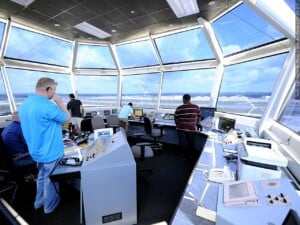The U.S. urgently needs thousands of air traffic controllers. Here’s what the job requires.

(CBS NEWS) – Sources from CBS say the government shutdown highlighted a fragile link in the nation’s aviation system: finding enough air traffic controllers to keep flights on schedule. The 43-day closure, during which controllers were required to work without pay, has only heightened that challenge.
“It’s a good job with good benefits, but partisan fighting over appropriations is not an ideal situation to try to bring in new air traffic controllers and convince them that this is a good career field,” Tim Kiefer, a retired air traffic controller who is now a professor of air traffic management at Embry-Riddle Aeronautical University, told CBS News. “It’s not a positive to try to bring people into this industry by saying, ‘You never know if you’re not going to get paid.'”
The shutdown saw a spike in the number of controllers choosing to retire, according to U.S. Secretary of Transportation Sean Duffy. The spectacle could also scare away younger workers from entering the field, Kiefer said.
“If you are a brand new person looking to enter a career, you may be thinking twice if you have to worry whether you’re going to be paid or not. That may be a deterrent, and they might find another job because of that,” he added.
A spokesperson from the Department of Transportation told CBS News that “the failure to pay air traffic controllers for 44 days created uncertainty, drove many experienced controllers out of the profession and harmed the recruitment pipeline.”
“No one wants to enter a job where their paycheck could be held hostage,” the spokesperson added.
In 2024, the U.S. had roughly 11,700 certified professional controllers and certified controllers in training, leaving the nation some 4,000 short of the FAA’s target staffing level. The agency expects to hire at least 8,900 new air traffic controllers through 2028, while nearly 7,000 are projected to leave over the same period.
The FAA hit its hiring target in 2025, bringing in 2,026 new air traffic controllers, according to the agency.
“This administration is working all avenues from increasing starting salaries for controllers to streamlining the hiring process to effectively bring about the Golden Age of Travel and ensure America has the safest airspace in the world,” the Transportation Department spokesperson said.
What are the qualifications?
On the FAA’s website, Duffy describes controlling air traffic as “one of the best, most rewarding jobs in America.” He also highlighted “the urgent need to do all that we can to recruit more people to join in our shared mission of safety in our skies.”
Recruiting prospective air traffic controllers is one thing, but getting them to stick with the roughly four years of training required to be certified by the FAA is another matter, according to industry experts.
“The washout rate at various stages of the controller recruitment and training process is high,” Robert Poole, director of transportation policy at the Reason Foundation, a group promoting libertarian principles, told CBS News.
Before someone qualifies to train at the FAA’s Air Traffic Controller Academy in Oklahoma City, Okla., job candidates must undergo a rigorous application process. To even apply through USAJobs, the federal government’s official employment site, they must meet the following criteria:
- Be a U.S. citizen
- Be under the age of 31
- Pass the FAA air traffic pre-employment tests, including the Air Traffic Controller Specialists Skills Assessment Battery (ATSA)
- Speak English clearly enough to be understood over communications equipment
- Have one year of progressively responsible work experience, or a Bachelor’s degree, or a combination of at least one year of post-secondary education and work experience
Aspiring controllers must also pass an exam that the FAA says predicts candidates’ “aptitude to be an air traffic controller.” Within a week, they are notified if they have passed.
Stephen Abraham, a retired air traffic controller formerly based at John F. Kennedy International Airport in Queens, New York, told CBS News that the aptitude exam weeds out many job candidates.
“It’s an assessment that determines if you have the right mental makeup to be an air traffic controller,” he said, noting that people can not prepare or study for the test. “If you succeed, they send you to Oklahoma City for eight to 12 weeks, where your training is more tailored toward success.”
Candidates who pass the test must then undergo comprehensive medical and background checks before they begin training at the academy. The medical red flags include using certain types of contact lenses to correct their vision, which is automatically disqualifying, and abnormal blood pressure.
According to the FAA, fewer than 10% of applicants meet the agency’s requirements to work as an air traffic controller and gain admission to the training program.
How much do controllers earn?
Once enrolled at the Oklahoma City academy, students spend months learning the basics of controlling the nation’s airspace, such as understanding where to position planes on tabletop models of airports, Abraham explained. As they progress, they start using simulators to practice managing air traffic.
Other training focuses on how to communicate with pilots and other controllers assigned to different parts of the airspace, as well as how to determine the best flight routes based on changing weather conditions and other factors.
In time, trainees are assigned to an air traffic control facility, typically a control tower at a small airport with lighter plane traffic, where they spend an additional two to four years working as controllers under the supervision of more experienced staff.
Joining the FAA academy isn’t the only path to becoming a controller. Candidates can instead attend a college that offers an FAA-certified curriculum, and then proceed directly to on-the-job training.
In 2024 (the last year for which federal data is available), the median annual wage for air traffic controllers was $144,580, according to the Bureau of Labor Statistics.
But pay varies widely based on experience and location. Annual income for less experienced controllers at smaller airports is closer to $60,000, according to aviation experts. Abraham said controllers’ pay can rise as they rise to working at busier facilities, gain experience and get promoted.
“A lot of people get to that point, and when they are at their first facility, trying to learn to control real traffic, some just don’t make it,” Poole said. “It’s more stressful than being a pilot, who flies a route from point A to B mostly on autopilot.”




